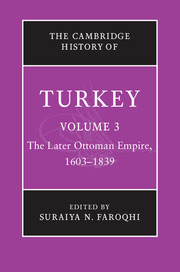Book contents
- Frontmatter
- PART I BACKGROUND
- PART II AN EMPIRE IN TRANSITION
- 4 Political culture and the great households
- 5 War and peace
- 6 Public finances: the role of the Ottoman centre
- PART III THE CENTRE AND THE PROVINCES
- PART IV SOCIAL, RELIGIOUS AND POLITICAL GROUPS
- PART V MAKING A LIVING
- PART VI CULTURE AND THE ARTS
- Glossary
- Bibliography
- Index
- References
4 - Political culture and the great households
from PART II - AN EMPIRE IN TRANSITION
Published online by Cambridge University Press: 28 March 2008
- Frontmatter
- PART I BACKGROUND
- PART II AN EMPIRE IN TRANSITION
- 4 Political culture and the great households
- 5 War and peace
- 6 Public finances: the role of the Ottoman centre
- PART III THE CENTRE AND THE PROVINCES
- PART IV SOCIAL, RELIGIOUS AND POLITICAL GROUPS
- PART V MAKING A LIVING
- PART VI CULTURE AND THE ARTS
- Glossary
- Bibliography
- Index
- References
Summary
The Ottoman Empire was patrimonialin organisation and Islamicin ideals and values: it was an Islamic sultanate, which also belonged to a larger category of patrimonial monarchies, or states conceived on the model of vastly extended households. At the centre, the Ottoman state consisted of the sultan and the dynasty, the ideas and values that legitimised the imperial system, the formal apparatus – organisational, regulatory and procedural – of government, and the elites who worked within that apparatus. The ruling elites were askeri (‘military’, whether all of them were literally soldiers or not), as contrasted to reaya (‘flocks’, subjects). Officially, the armed, tax-exempt status of the elites, as well as distinctions in dress, sharply differentiated between askeri and reaya, between state and society. All constituents of the government united in a political balance or imbalance that changed over time with important results, as did the equilibrium between state and society.
This complex system changed profoundly between 1603 and 1838. Scholars long envisaged these changes as a decline, following the empire’s earlier rise and preceding its nineteenth-century reform era. However, if certain things fell in this period, others rose. These two centuries do not display a single upward or downward trend. Even shorter-term trends mask divergent trajectories followed by different parts of the imperial system. Analogously, the period 1603– 1789 has been characterised as one of decentralisation and weakening state power. Yet the formation of new provincial power centres may have signified instead the emergence of new interlocutors between state and society and the creation of denser centre–periphery linkages, at least until late eighteenth-century crises provoked a trend back towards centralisation.
- Type
- Chapter
- Information
- The Cambridge History of Turkey , pp. 63 - 80Publisher: Cambridge University PressPrint publication year: 2006
References
- 2
- Cited by

